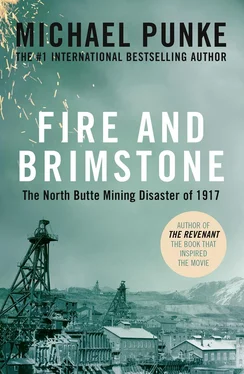The heat of the flames and the smoke they threw off reversed the Granite Mountain draft. The downdraft, which had initially sucked the fire downward, turned updraft. Now pulled from above, the fire began to race up the half mile of shaft above the 2,400 Station—feeding on the tinder-dry, chemically treated timbers.
Sullau began to confront the enormity of his mistake. “For God’s sake, get the men out!” he yelled. “Get ’em out!” 12
Baldy Collins and the two other men reached the surface and piled out of the cage. The fire, they knew, would burn quickly up the wooden shaft. Speed was essential if they were to save the men working below. Desperately they set to work, attaching additional cages to the hoist lines so that more men could be lifted at a time. 13
Two of the men assisting Baldy on the surface were Peter Sheridan and Mike Conroy. Sheridan and Conroy were “station tenders” responsible for the 2,200 Station. A fire, they knew from Baldy, had broken out only a few hundred feet below the 2,200— their station, where their men were at work. The tenders argued with Baldy to be lowered down in an effort to bring the men up. Baldy refused, worried now that the hoist’s electric signaling system might not be working. He ordered the two men to stay on the surface until he had a chance to consult with the engineer who operated the hoist—two hundred feet away, out of sight, on the inside of the engine room. Baldy turned and ran for the engine room.
Before Baldy could reach the engineer, Sheridan and Conroy took matters into their own hands, signaling to be lowered to the 2,200 Station. A third man, Con McLafferty, jumped onboard with them. 14The cage dropped into the shaft.
The Granite Mountain shaft had four electric signal systems through which the men on the surface could communicate with the men in the depths of the mine. By midnight—only fifteen minutes after Ernest Sullau’s lantern set the cable ablaze—the roaring shaft fire had destroyed all four. 15The communication system was critical to the operation of the hoists, and the severance of signal lines had immediate and horrific consequences.
By the time Sheridan, Conroy, and McLafferty reached the 2,200 Station, the fire was close enough to the cage that McLafferty jumped out and “refused to take the chance of going up.” Instead, he retreated into the mine workings at the 2,200 level, ultimately surviving to tell the tale. 16
Sheridan and Conroy must have calculated that they could still outrun the flames aboard the hoist. Like hundreds of other men at work in the mine that night, the two station tenders made snap judgments that sealed their fate. To signal the engineer on the surface to pull them up, they would have attempted to ring the bell—unaware that the ruined electrical wires kept their desperate signal from reaching the surface. By now the fire was virtually exploding up the shaft. Within a few instants, Sheridan and Conroy were enveloped in flames.
On the surface, the engineer, with Baldy at his side, became increasingly uneasy. 17From the station where he operated the levers that raised and lowered the hoists, the engineer watched a giant gauge that showed the position of the cage—sitting at the 2,200 Station. But there had been no signal to raise it. The miners communicated with the surface in a sort of abbreviated version of Morse code. In each station was a cord with a large handle. Pulling the cord completed an electrical circuit, ringing a bell in the hoist house. There was a specific call to indicate that the cage was clear: two bells, pause, one bell, pause, two bells . Once the engineer heard this signal, he knew it was safe to move the cage. In those minutes around midnight, though, he heard nothing from the men on the 2,200.
At about that time smoke started to pour from the Granite Mountain shaft. Frantically, the engineer raised the cage. 18
By the time it emerged from the collar, the cage was surrounded by fire “flying from the shaft like a gigantic torch.” The engineer stopped the cage about forty feet above the surface, dangling from the gallows headframe atop a “geyser of flames.” Horrified witnesses could see the charred remains of Sheridan and Conroy, locked in a “death embrace.” 19
In its coverage of the incident, the Butte Miner attempted to reassure its readers with the assertion that “the terrific heat without doubt quickly snuffed out the lives of the two station tenders,” though it also noted that the victims were found “with arms and feet burned away.” Other accounts were even more graphic. The Butte Daily Post reported that Sheridan and Conroy were “burned almost to a crisp” and that “even the hair and flesh on their heads [was] gone, so that their skulls were laid bare.” 20
The flames and heat from the fire made it impossible for onlookers to approach the cage. Eventually enough water was poured into the shaft so that two firemen, Angus McLeod and George Lapp, could at least remove the bodies.
With the fire and death at the mouth of Granite Mountain, few onlookers would have noticed what happened at 12:10 A.M., when smoke began to rise from the Speculator shaft—800 feet away. 21
Ernest Sullau could not see the Speculator shaft from his position near the Granite Mountain’s 2,400 Station. He didn’t need to. As a veteran of the North Butte Mining Company, Sullau understood intuitively the interconnection between the Granite Mountain and the Spec.
Butte sat atop a labyrinth made up of thousands of miles of underground mining works. 22The North Butte’s holdings illustrate a small portion of this subterranean world. Its two main shafts—Granite Mountain and the Speculator—ran straight down, each with its own headframe and hoist system to transport men and ore. The two shafts stood 800 feet apart, connected by at least ten crosscut tunnels. If the mine is compared to a human body, the shafts and crosscuts were like main arteries. Branching off of these arteries were hundreds of smaller veins and capillaries. There were “drifts”—horizontal excavations to remove ore; “stopes”—excavations in the shape of a step; and “manways”—man-size, vertical shafts with a ladder inside that allowed men to climb up and down between different levels. 23
And all of that was just the property of the North Butte Mining Company. The Granite Mountain and the Spec connected directly, at multiple levels, to five other mines, which were owned by Anaconda.
Ernest Sullau knew that the deadly consequences of the fire—his fire—would not be contained in one shaft, or even in one mine. The smoke and fumes spewing forth from the Granite Mountain shaft would spread throughout the far-flung recesses of this underground world, where hundreds of men were at work. Sullau also knew something else—that the fumes were filled with deadly gas.
There is no doubt that at this juncture, minutes after the start of the fire, Ernest Sullau could have saved himself. Though the main shaft was ablaze and its hoist no longer a viable option, other clear avenues of escape were within easy reach. 24With his long years of experience, Sullau knew the mine workings as well as the streets surrounding his own home.
There is no record of his thoughts as Ernest Sullau made the decision that sealed his own fate that night, but we know he did not run away.
Three
“THE RICHEST HILL ON EARTH”
No one knows it yet, but I have discovered the richest hill on earth.
—ATTRIBUTED TO COPPER KING MARCUS DALY
In the spring of 1856, a small party led by Caleb E. Irvine camped on a high plain below a distinctive butte near the headwaters of the Clark Fork River. They were traders, not miners, but they made a discovery that hinted at the future of the hill on which they stood. Near their camp, Irvine discovered a deep trench, dug into an outcropping of exposed quartz. Next to the trench were elk antlers, apparently used as gads to scrape out the hole.
Читать дальше












